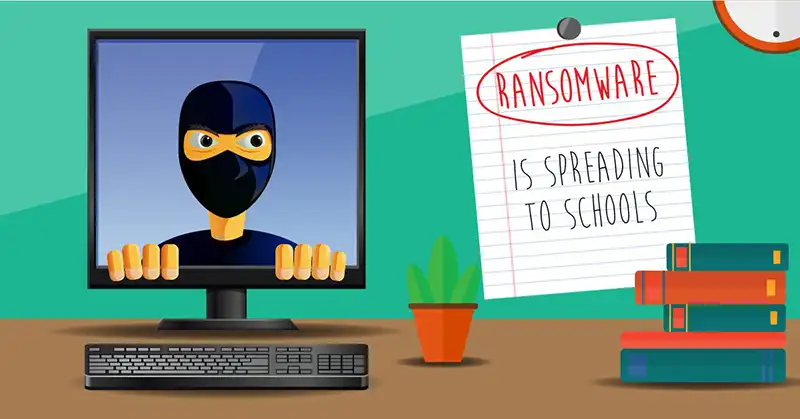Cyber Attacks on Schools: How to Implement Cyber Security Against Ransomware Targeting Education
Ransomware is everywhere and it is not even sparing educational institutes. Multiple researches have shown a 3% increase in the ransomware attacks on education sector this year, higher than any other individual industry. Ironically, educational institutes consider themselves safe from ransomware, which has been proven wrong already when schools hit by ransomware majorly increasing across the globe. It is high time schools and different other institutes that provide education adopted strong protective measures against ransomware & implement cyber security in public schools. In this write-up, we will talk about the increasing cyber attacks on schools and other educational institutes & Are public schools prepared for cyber attacks? Readers will get also informed how they can safeguard the data of educational institutes.

Why are Ransomware Attackers Targeting Educational Institutes?
Like other sectors, education sector also possess a vast amount of valuable data. Surprisingly, the institutes do not consider the data valuable, unlike the hackers. Therefore, education institutes have minimum protection & lack of cyber security in public schools to secure their data. This one mistake has unknowingly made them easy targets of the ransomware attack. Date of birth, home address, contact number, Social Security Number, bank account number, etc., of students and teachers, are stored in an educational institute , this is why hackers target nation’s schools. If exposed, all of which can pose threat to the concerned person and if not recovered, the procedure of education institutions will get hampered badly.
How Ransomware may Infect Schools and What Preventive Measures to be Taken
To prevent ransomware from harming the educational institutions & Cyber Attacks on Schools , various techniques can be implemented. These measures should be taken according to the ways through which educational institutes may get infected. We have listed some points here that educational institutes should be careful about & implement cyber security in public schools:
1. Human Error:
The error or negligence of the users is one of the major reasons that educational institutes face ransomware attacks. Despite having knowledge about malware and phishing attacks, users often click on suspicious links that infect the system. Also, access to sensitive documents are often available to all, as a result, some people end up exposing them unintentionally.
Solution: Make sure that only a handful of people can access private and sensitive data of your institute. Provide basic training to students, teachers, and other executives on cybersecurity. Arrange for secured login system to access school network.
2. Unknown Devices:
Many schools use “Bring Your Own Device” (BYOD) policy, making the system of the school more vulnerable. Thus, many unprotected endpoint devices get connected to the network and pose a significant threat to the network security. These unprotected devices include laptop, notebook/ netbook, USB devices, tablets, smartphones, etc.
Solution: To secure your network from unauthorized intrusion, cancel BYOD policy if possible to prevent Cyber Attacks on Schools . Also, track every device that is entering the network of the institute.
3. Third-Party Programs or Shared Files:
Using third-party applications may lead to ransomware infection. Ransomware like WannaCry enters certain systems as a software update. If your school uses collaborative suites like Google Apps or GAFE or Office 365, malware can enter the system through shared files also.
Solution: Only use third-party programs from trusted sources and avoid installing unnecessary application on the systems of the schools. Take extra precaution while using GAFE, Google Apps or Office 365.
4. Outdated Technology:
Ransomware can affect your system even without any user interaction. If you are using an outdated system or technology, it is easy for the hackers to infect that system. Many schools have a minimum budget for the technological upgrade, while some have no budget at all. Any type of outdated technology is vulnerable to ransomware attack and educational institutes must be aware of this fact.
Solution: Always try to use the latest and updated technology. Always update installed OS and applications with the latest version.
5. Lack of Backup:
It is possible to get infected by ransomware malware despite having taken all preventive measures. The reason behind it is that attackers constantly changing their mode of attack and adopting sophisticated techniques. No backup of an educational institute data puts that institute in a far more dangerous condition. Without any backup, they are bound to pay the ransomware to the attackers.
Solution: Arrange a secured backup of all data of the educational institution. If possible, keep multiple backups as a precaution. Use GAFE Backup to protect if your institute uses GAFE account.
Are Public Schools Prepared for Cyber Attacks ?
From the above discussion, it is clear that educational institutes all over the world are facing a serious threat from the ransomware attacks. They must take all possible preventive measures, implement cyber security in public schools and also backup their data as a remedial solution to the attack & prevent Cyber Attacks on Schools.

